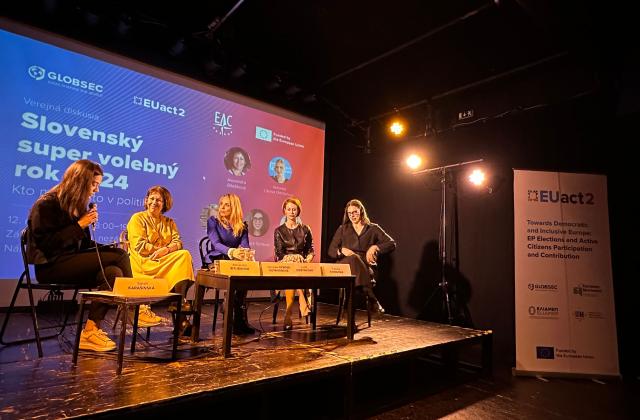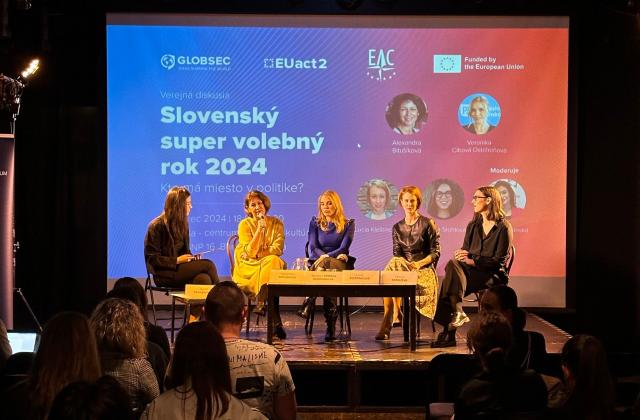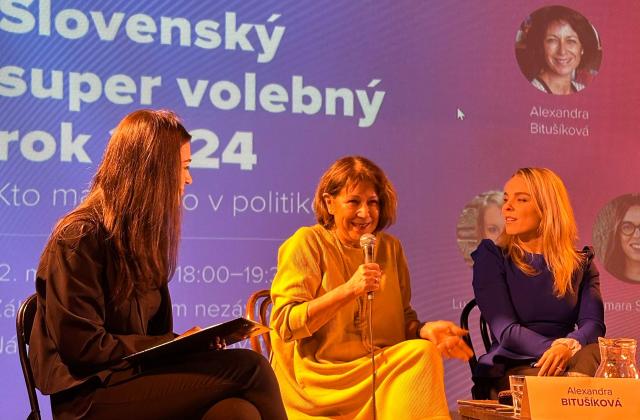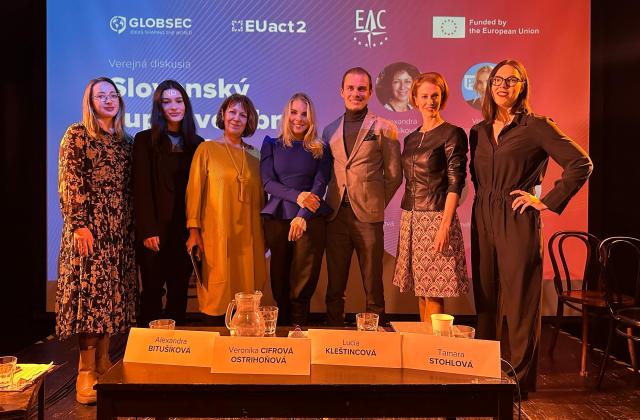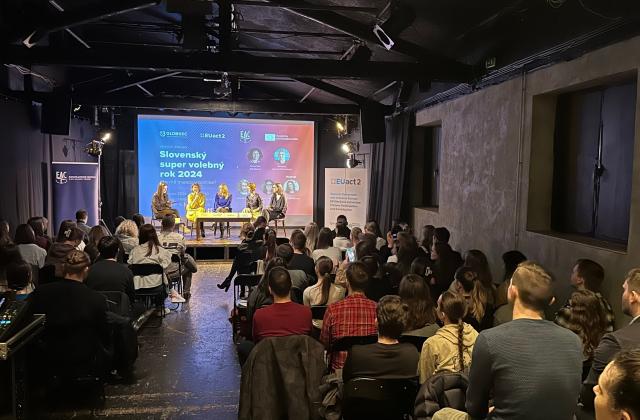Event Summary: Slovak Super Election Year 2024: Who Has a Place in Politics?
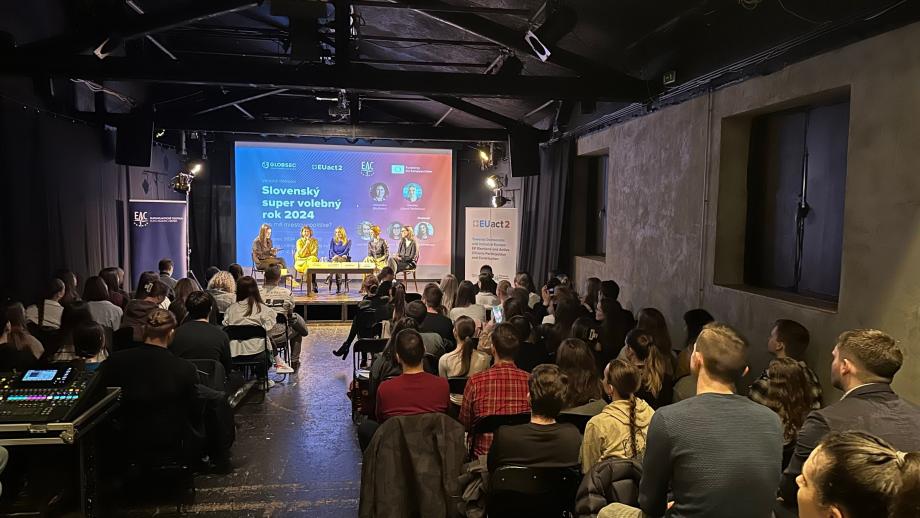
The public discussion titled “Slovak Super Election Year 2024”, organised by GLOBSEC as part of the EUact2 project, was held on the 12th of March 2024 in Banská Bystrica, Slovakia. The event was aimed at discussing the current position of women in Slovak politics as well as possible instruments that could strengthen their position in the future. During the event, the panellists also touched upon the non-participation of female candidates in the ongoing presidential campaign in Slovakia and the importance of the upcoming European elections.
In front of an engaged audience of more than 60 people, four panelists discussed the challenges facing women in political campaigns and the Slovak political domain itself, specific tools that could strengthen the position of women at the party level and in parliament, as well as possible reasons why there is not a single female candidate standing in the current presidential election campaign.
The panel consisted of Alexandra Bitušíková, professor at Matej Bel University conducting research on women empowerment, Veronika Cifrová Ostrihoňová, moderator and candidate for the European elections for Progressive Slovakia, Lucia Kleštincová, coach and candidate for the European elections for Volt Slovakia, and Tamara Stohlová, member of the Slovak Parliament for Progressive Slovakia. The event was moderated by Sarah Karashinska, President of the Euro-Atlantic Centre student association at University Mateja Bela.
Audience members were predominantly young students and those interested in national Slovak politics. All the speakers offered interesting perspectives that resonated significantly with the audience in-person, as well as generated engagement across various social media platforms.
Professor Bitušíková opened the panel with a comprehensive summary of the development of the status of women in former Czechoslovakia and later democratic Slovakia. She made the noteworthy observation that quotas for women's representation in parliament were introduced already during communism, but their effectiveness was questionable and did not lead to the actual improvement of the status of women in politics. The professor inferred that similar quotas for women's representation in politics would be of use in contemporary Slovakia where female politicians compose barely 20% of Slovak parliamentary members.
Ms Cifrová Ostrihoňová argued that men should be invested in making sure that women and minorities in Slovakia feel equally respected and supported which would represent the clearest sign that Slovakia is a developed country. She agreed that certain temporary quotas would be necessary until the balance between men and women in politics is at least partially addressed organically. She also denoted that besides political measures, it is also important to discuss the topic of gender equality and support more broadly for women in families, schools, or among friends. Boys and girls should be raised to respect each other breaking the existing stereotypes in the society.
Ms Kleštincová also supported the introduction of quotas to strengthen women in politics, which would help them break the glass ceiling so that the proportion of women in parliament exceeds 20%. As an example, she pointed out that in the pan-European party Volt, which she represents, it is obligatory that a leadership duo of a man and woman should be present in every leading group. Ms Kleštincová was convinced that for there to be a real change in the status of women in politics, such legislation needs to come from the European level. Like other issues that transcend borders, it is necessary to start discussing these topics at a pan-European level.
Finally, Ms Stohlová, a current member of the Slovak Parliament, presented a case study of the zipper system, a strategy used by Progressive Slovakia at the last parliamentary elections that placed an equal number of men and women on its candidate list in alternating order. Thanks to this system, Progressive Slovakia secured equal number of women as men into the parliament. Ms Stohlová was convinced that quotas for proportional representation of women should find their way into both parliamentary and party structures. Furthermore, it is also important that women are placed on the candidate lists where the probability of election is realistic and not towards the bottom which occurs frequently.
Key takeaways:
- Slovak political parties as well as the Slovak Parliament should introduce quotas with the aim of a establishing more equal gender representation. A first step could be introducing such a principle on the level of party presidencies or parliamentary committees. Quotas would not necessarily have to be a 50%-50% ratio, but, for example, 40%-40%, while the remaining 20% could be distributed freely, regardless of gender.
- To increase the number of women in parliament, it is not enough to only have quotas, but also to improve the general societal and social conditions towards women, to adapt working conditions, to increase the number of places in nurseries or to improve the level of health care. All these factors would contribute to relieving women of their non-work responsibilities, allowing them to participate more fully in social life.
- We should strive to create constructive partnerships and cooperation around women's empowerment in society and politics between MEPs and members of national parliaments. It is recommendable that the European Commission should adopt legislation that harmonises the promotion of the status of women in the Member States.
- In the medium term, various mentoring and leadership activities funded by public and private sources would be a major asset to advance the standing of women. Men should be equally involved in these initiatives as mentors and coaches and should become allies of women in this field.
- The European Commission should continue to increase its insistence on the implementation of gender equality and anti-sexual harassment plans when assessing applications for European projects, including from academia.
